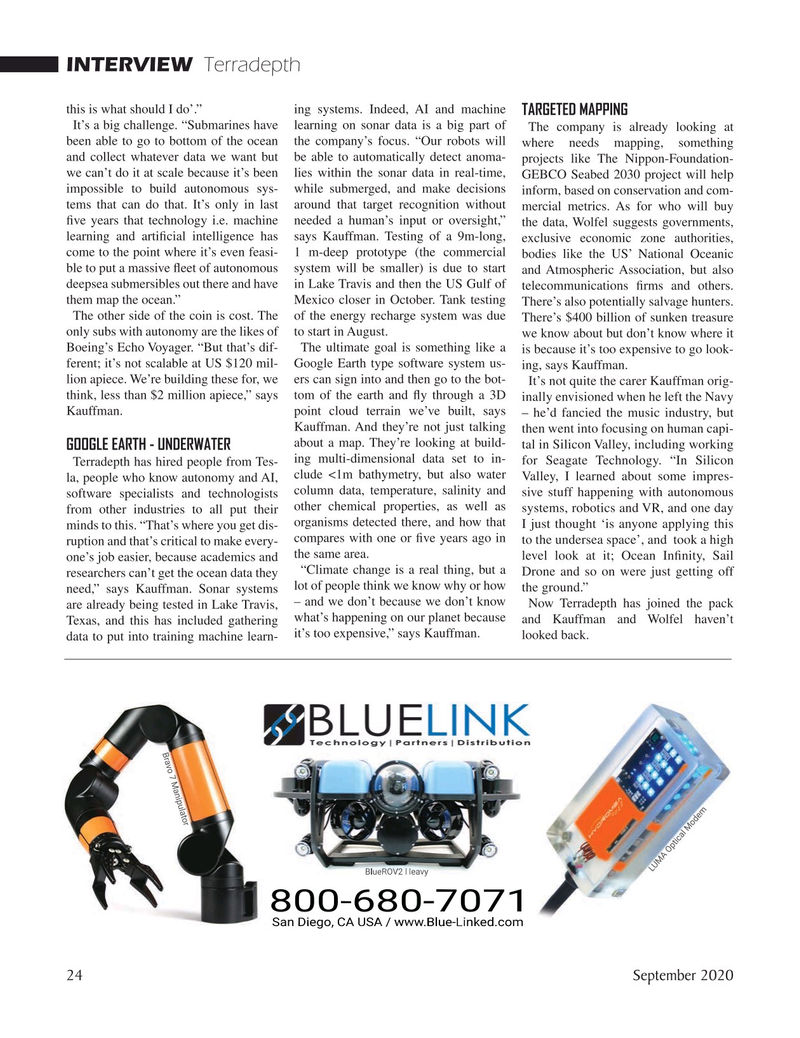
Page 24: of Marine Technology Magazine (September 2020)
Read this page in Pdf, Flash or Html5 edition of September 2020 Marine Technology Magazine
INTERVIEW Terradepth this is what should I do’.” ing systems. Indeed, AI and machine
TARGETED MAPPING
It’s a big challenge. “Submarines have learning on sonar data is a big part of
The company is already looking at been able to go to bottom of the ocean the company’s focus. “Our robots will where needs mapping, something and collect whatever data we want but be able to automatically detect anoma- projects like The Nippon-Foundation- we can’t do it at scale because it’s been lies within the sonar data in real-time, GEBCO Seabed 2030 project will help while submerged, and make decisions inform, based on conservation and com- impossible to build autonomous sys- tems that can do that. It’s only in last around that target recognition without mercial metrics. As for who will buy ? ve years that technology i.e. machine needed a human’s input or oversight,” the data, Wolfel suggests governments, learning and arti? cial intelligence has says Kauffman. Testing of a 9m-long, exclusive economic zone authorities, 1 m-deep prototype (the commercial bodies like the US’ National Oceanic come to the point where it’s even feasi- ble to put a massive ? eet of autonomous system will be smaller) is due to start and Atmospheric Association, but also deepsea submersibles out there and have in Lake Travis and then the US Gulf of telecommunications ? rms and others.
Mexico closer in October. Tank testing There’s also potentially salvage hunters. them map the ocean.”
The other side of the coin is cost. The of the energy recharge system was due There’s $400 billion of sunken treasure only subs with autonomy are the likes of to start in August. we know about but don’t know where it
The ultimate goal is something like a is because it’s too expensive to go look-
Boeing’s Echo Voyager. “But that’s dif- ferent; it’s not scalable at US $120 mil- Google Earth type software system us- ing, says Kauffman. lion apiece. We’re building these for, we ers can sign into and then go to the bot-
It’s not quite the carer Kauffman orig- think, less than $2 million apiece,” says tom of the earth and ? y through a 3D inally envisioned when he left the Navy point cloud terrain we’ve built, says – he’d fancied the music industry, but
Kauffman.
Kauffman. And they’re not just talking then went into focusing on human capi- about a map. They’re looking at build- tal in Silicon Valley, including working
GOOGLE EARTH - UNDERWATER ing multi-dimensional data set to in- for Seagate Technology. “In Silicon
Terradepth has hired people from Tes- la, people who know autonomy and AI, clude <1m bathymetry, but also water Valley, I learned about some impres- software specialists and technologists column data, temperature, salinity and sive stuff happening with autonomous from other industries to all put their other chemical properties, as well as systems, robotics and VR, and one day organisms detected there, and how that I just thought ‘is anyone applying this minds to this. “That’s where you get dis- compares with one or ? ve years ago in to the undersea space’, and took a high ruption and that’s critical to make every- level look at it; Ocean In? nity, Sail one’s job easier, because academics and the same area. “Climate change is a real thing, but a Drone and so on were just getting off researchers can’t get the ocean data they need,” says Kauffman. Sonar systems lot of people think we know why or how the ground.”
Now Terradepth has joined the pack are already being tested in Lake Travis, – and we don’t because we don’t know
Texas, and this has included gathering what’s happening on our planet because and Kauffman and Wolfel haven’t it’s too expensive,” says Kauffman. looked back. data to put into training machine learn- 24 September 2020
MTR #7 (18-33).indd 24 9/11/2020 8:44:40 AM

 23
23

 25
25
